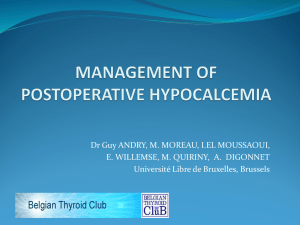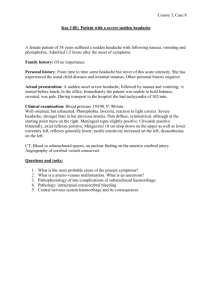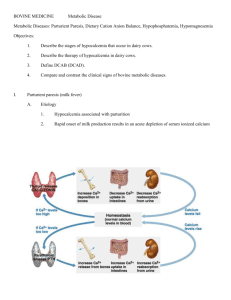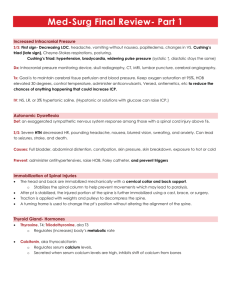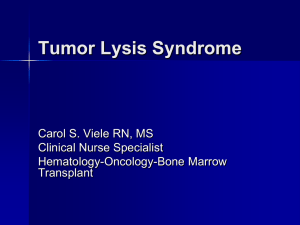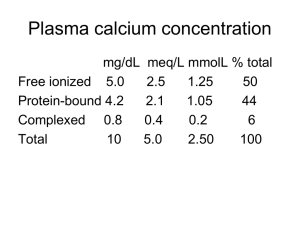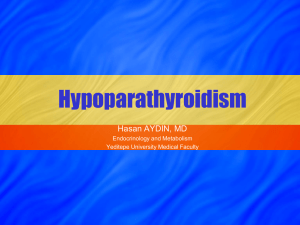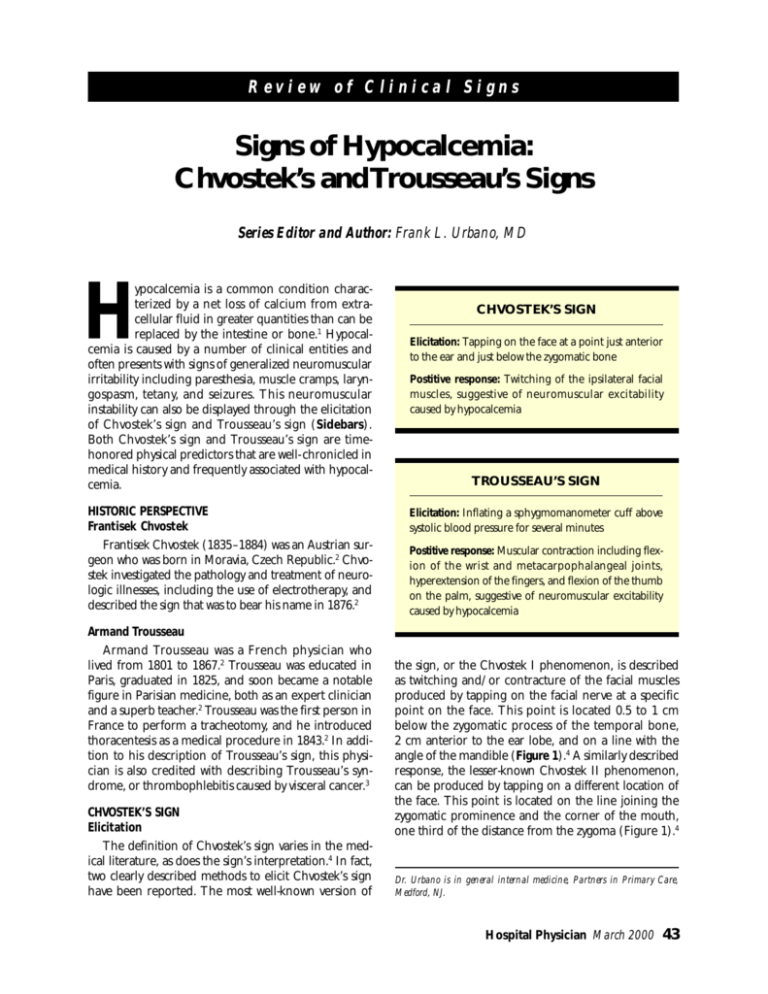
Review of Clinical Signs
Signs of Hypocalcemia:
Chvostek’s and Trousseau’s Signs
Series Editor and Author: Frank L. Urbano, MD
ypocalcemia is a common condition characterized by a net loss of calcium from extracellular fluid in greater quantities than can be
replaced by the intestine or bone.1 Hypocalcemia is caused by a number of clinical entities and
often presents with signs of generalized neuromuscular
irritability including paresthesia, muscle cramps, laryngospasm, tetany, and seizures. This neuromuscular
instability can also be displayed through the elicitation
of Chvostek’s sign and Trousseau’s sign (Sidebars).
Both Chvostek’s sign and Trousseau’s sign are timehonored physical predictors that are well- chronicled in
medical history and frequently associated with hypocalcemia.
H
HISTORIC PERSPECTIVE
Frantisek Chvostek
Frantisek Chvostek (1835–1884) was an Austrian surgeon who was born in Moravia, Czech Republic.2 Chvostek investigated the pathology and treatment of neurologic illnesses, including the use of electrotherapy, and
described the sign that was to bear his name in 1876.2
Armand Trousseau
Armand Trousseau was a French physician who
lived from 1801 to 1867.2 Trousseau was educated in
Paris, graduated in 1825, and soon became a notable
figure in Parisian medicine, both as an expert clinician
and a superb teacher.2 Trousseau was the first person in
France to perform a tracheotomy, and he introduced
thoracentesis as a medical procedure in 1843.2 In addition to his description of Trousseau’s sign, this physician is also credited with describing Trousseau’s syndrome, or thrombophlebitis caused by visceral cancer.3
CHVOSTEK’S SIGN
Elicitation
The definition of Chvostek’s sign varies in the medical literature, as does the sign’s interpretation.4 In fact,
two clearly described methods to elicit Chvostek’s sign
have been reported. The most well-known version of
CHVOSTEK’S SIGN
Elicitation: Tapping on the face at a point just anterior
to the ear and just below the zygomatic bone
Postitive response: Twitching of the ipsilateral facial
muscles, suggestive of neuromuscular excitability
caused by hypocalcemia
TROUSSEAU’S SIGN
Elicitation: Inflating a sphygmomanometer cuff above
systolic blood pressure for several minutes
Postitive response: Muscular contraction including flexion of the wrist and metacarpophalangeal joints,
hyperextension of the fingers, and flexion of the thumb
on the palm, suggestive of neuromuscular excitability
caused by hypocalcemia
the sign, or the Chvostek I phenomenon, is described
as twitching and/or contracture of the facial muscles
produced by tapping on the facial nerve at a specific
point on the face. This point is located 0.5 to 1 cm
below the zygomatic process of the temporal bone,
2 cm anterior to the ear lobe, and on a line with the
angle of the mandible (Figure 1).4 A similarly described
response, the lesser-known Chvostek II phenomenon,
can be produced by tapping on a different location of
the face. This point is located on the line joining the
zygomatic prominence and the corner of the mouth,
one third of the distance from the zygoma (Figure 1).4
Dr. Urbano is in general internal medicine, Partners in Primary Care,
Medford, NJ.
Hospital Physician March 2000
43
Urbano : Signs of Hypocalcemia : pp. 43–45
Figure 2. Illustration of the elicitation of Trousseau’s sign.
Adapted with permission from Netter FH: Clinical manifestations
of acute hypocalcemia. In The Ciba Collection of Medical Illustrations,
vol 4. Summit, NJ: Ciba Pharmaceutical Company, 1965:185.
B
A
Figure 1. Illustration of the facial points where A) the Chvostek
I phenomenon and B) the Chvostek II phenomenon can be elicited. Hoffman E:The Chvostek sign: a clinical study. Adapted with
permission from Am J Surg 1958;96:33 –37.
been positive in persons without any known disease.
One study demonstrated a positive Chvostek’s sign in
nearly 25% of healthy individuals.4 Another study
showed that 29% of patients with laboratory- confirmed
hypocalcemia had a negative Chvostek’s sign.8 In turn,
the medical community considers Chvostek’s sign as
only a crude indicator of neuromuscular irritability and
an unreliable indicator of hypocalcemia.9
Pathophysiology
The proposed mechanism for Chvostek’s sign is
thought to involve direct mechanical stimulation of the
motor fibers in the facial nerve.7 Previously, Chvostek’s
sign was thought to be a reflex. However, this reflex is
now believed to occur only occasionally; further, the reflex is believed to only be involved with the Chvostek II
version of the sign. Another purported explanation for
the mechanism was direct stimulation of the facial
muscles, which subsequently contracted and twitched,
but this theory has been disproven as well.
TROUSSEAU’S SIGN
Elicitation
Trousseau’s sign is more consistently defined in the
medical literature than Chvostek’s sign. Most simply
described, Trousseau’s sign presents as carpopedal
spasm occurring after a few minutes of inflation of a
sphygmomanometer cuff above systolic blood
pressure.5 Occlusion of the brachial artery causes flexion of the wrist and metacarpophalangeal joints, hyperextension of the fingers, and flexion of the thumb on
the palm, producing the characteristic posture called
main d’accoucheur (Figure 2).9 Trousseau’s sign is
thought to be both sensitive and specific for hypocalcemic tetany.1,9 In addition to the obvious visual manifestations, patients with a positive Trousseau’s sign may
also experience paresthesia of the fingers, muscular fasciculations or twitches of the fingers, and a sensation of
muscular cramping or stiffness.10
Differential Diagnosis
As previously mentioned, Chvostek’s sign is a classic
signification of hypocalcemia. However, some studies
have demonstrated that hypocalcemia is not the only
condition in which a positive Chvostek’s sign may be
seen. Other conditions that have produced Chvostek’s
sign include rickets, diphtheria, measles, scarlet fever,
whooping cough, and myxedema. The sign has also
Pathophysiology
The proposed mechanism for Trousseau’s sign is
increased excitability of the nerves in the arm and forearm, ostensibly caused by hypocalcemia, which, in
turn, causes the muscular contractions. These conditions are exacerbated by ischemia produced by the
sphygmomanometer, resulting in the twitching that
defines the sign.5
In both instances, the common feature is the twitching
response, which may involve any or all of the muscles
supplied by the facial nerve on that side, including the
circumoral muscles and the orbicularis oculi.5,6
44 Hospital Physician March 2000
Urbano : Signs of Hypocalcemia : pp. 43–45
Trousseau-von Bonsdorff Test
The Trousseau-von Bonsdorff test has been correlated with the presence of Trousseau’s sign. 10 The
Trousseau-von Bonsdorff test is performed immediately
after deflating the sphygmomanometer. The patient is
instructed to breathe deeply at a rate of 40 breaths/min
and is then observed for the previously described carpopedal spasm. One study found the Trousseau-von
Bonsdorff test to be a useful adjunct to Trousseau’s sign
when evaluating for the presence of hypocalcemia.10
Differential Diagnosis
As with Chvostek’s sign, hypocalcemia is not the
only condition that can produce a positive Trousseau’s
sign. Another common clinical entity that has been
known to cause a positive Trousseau’s sign is hypomagnesemia.9 Because this condition often occurs concomitantly with hypocalcemia, determination of the
electrolyte abnormality responsible for causing the two
separate positive responses is difficult.
COMPARISON OF CHVOSTEK’S SIGN AND TROUSSEAU’S
SIGN
Although the two signs have never been directly compared, Trousseau’s sign is believed to be more specific
for hypocalcemia than Chvostek’s sign. In one study,
94% of patients with confirmed hypocalcemia had a positive Trousseau’s sign, whereas only 1% of healthy patients demonstrated a positive Trousseau’s sign.10 In
addition, only 9% of normal patients had a positive
Trousseau-von Bonsdorff test.10
HYPOCALCEMIA
Clinical entities that may commonly result in hypocalcemia include hypoparathyroidism (especially of the
postsurgical variety), chronic renal failure, rhabdomyolysis, pancreatitis, tumor lysis syndrome, nephrotic syndrome, and dietary deficiency.9 Both Chvostek’s sign
and Trousseau’s sign may be present in patients with all
conditions that cause hypocalcemia; however, absence of
the signs does not preclude the diagnosis. Modern
blood chemistry analyzers have the ability to measure
both total and free serum calcium, which has greatly
assisted in the diagnosis of hypocalcemia. The treatment
of hypocalcemia consists of correcting the underlying
pathologic problem (if possible) and replacing the lost
calcium through pharmacologic means.
SUMMARY
In the current age of medicine, the utility of Chvostek’s sign and Trousseau’s sign has diminished with
the development of technology that is able to assess
serum calcium values. However, the signs may still be
helpful as crude determinations of the neuromuscular
excitability that occurs in patients with hypocalcemia.
Trousseau’s sign is likely to be a more specific indicator
of hypocalcemia than Chvostek’s sign, but both signs
are diagnostically useful, and attempts to both perform
and interpret the signs are an interesting challenge to
physicians and students of medicine.
HP
ACKNOWLEDGMENT
The author wishes to thank Margaret M. Franger,
MD, for her assistance in reviewing this manuscript.
REFERENCES
1. Bushinsky DA, Monk RD: Calcium. Lancet 1998;352:
306–311.
2. Firkin BG, Whitworth JA: Dictionary of Medical Eponyms,
2nd ed. New York: The Parthenon Publishing Group,
1996;68:401.
3. Stedman’s Medical Dictionary, 25th ed. Baltimore: Williams
and Wilkins, 1990:1539.
4. Hoffman E: The Chvostek sign: a clinical study. Am J
Surg 1958;96:33–37.
5. Netter FH: Clinical manifestations of acute hypocalcemia. In The Ciba Collection of Medical Illustrations, vol 4.
Summit, NJ: Ciba Pharmaceutical Company, 1965:185.
6. Noble J: Textbook of Primary Care Medicine, 2nd ed. St.
Louis: Mosby, 1996:550 –554.
7. Kugelberg E: The mechanism of Chvostek’s sign. Archives
of Neurology and Psychiatry. 1951;65:511–517.
8. Fonseca OA, Calverly JR: Neurological manifestations of hypoparathyroidism. Arch Intern Med 1967;120:
202–206.
9. Becker KL, ed: Principles and Practice of Endocrinology and
Metabolism, 2nd ed. Philadelphia: J.B. Lippincott Company, 1995;618:1766–1767.
10. Schaaf M, Payne CA: Effect of diphenylhydantoin and
phenobarbital on overt and latent tetany. N Engl J Med
1966;274:1228–1233.
Copyright 2000 by Turner White Communications Inc., Wayne, PA. All rights reserved.
Hospital Physician March 2000
45

